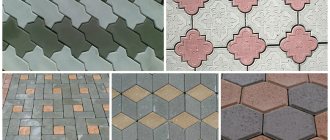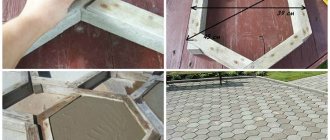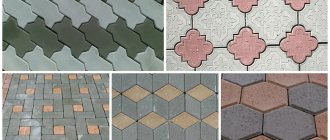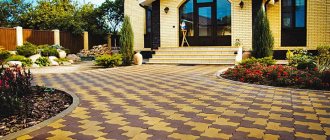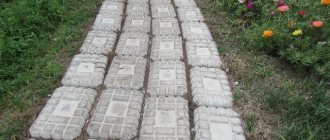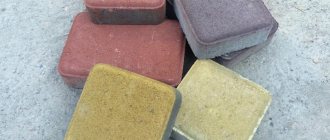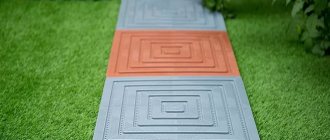Molds for paving slabs are special matrices for casting building material, which can be used at home to produce elements with your own hands. The need to create tiles may arise if you want to decorate the area with an original exclusive coating, saving significantly and getting exactly as much material as you need.
The advantages of paving garden paths, adjacent areas, and other landscape elements with paving slabs leave no one in doubt: the coating made in this way will be reliable and durable, beautiful and aesthetically pleasing, smooth and ideal. Using paving slabs, you can create a unique decor that is compatible with other elements of the architectural ensemble and landscape of the area.
Modern manufacturers offer a large assortment of tiles, which, however, is limited to the choice of standard patterns and colors, is high in cost, and requires costs for organizing loading and unloading operations and transportation. In view of all these features, many craftsmen prefer to make building materials with their own hands, using molds for the production of paving slabs.
Molds can be made from various materials - rubber, plaster, various types of plastic, wood, etc. You can buy ready-made templates or make your own, implementing a unique idea and saving a lot of money.
Types of paving slabs
Paving slabs come in a variety of shapes, colors and designs. Every year, manufacturers offer more and more new product positions, so the choice is quite large.
Variety of paving slab shapes:
- Rhombus - offers maximum freedom in terms of design: using several types of this type of element, you can even create 3D effects.
- Square - tiles can be made in different versions, with patterns. The standard size is 500x500x50 millimeters. By using tiles of different sizes and colors, you can also create original patterns.
- Clover - often used for paving squares and parks, made of concrete with granite crushed stone. The tile has a smooth surface, is not afraid of dirt, and is always clean and aesthetically pleasing.
- Brick - can withstand maximum loads, which is ensured by the shape of a geometrically regular parallelepiped.
- The wave lasts a long time without moving even under heavy loads. The coating is created with a puzzle effect, therefore it is very durable and beautiful (when using several colors, for example).
- Galvanized tiles with round edges are a good choice for summer cottages and suburban areas where there are no heavy loads. Looks good.
- English cobblestone - imitates brown or gray natural stone, produced by vibration casting, looks stylish and simple.
- Tiles with teeth on the sides guarantee the highest level of strength when joining elements; therefore, they are often laid where cars drive and there are heavy loads.
Materials for making paving slabs:
- Cement and sand - environmentally friendly, produced in a wide range of colors and shapes, usually obtained in a bright shade, very durable, not afraid of water and ultraviolet radiation, can be dismantled and re-laid. Typically, such tiles are used to make coverings for city parks and sidewalks.
- Clinker - tiles are obtained with a rough surface, safe and environmentally friendly, strong and durable. Usually the choice is represented by a large number of natural shades.
- Rubber - such tiles are used for arranging children's playgrounds and institutional areas. You won't be able to slip on such a surface, and even if you fall, the impact won't be strong. Even in icy conditions, the tiles are safe, as they provide good grip on shoes.
- Plastic (polymer and sand) - tiles are made by heating and melting polymers, sand and dyes, then pressed. The tiles do not contain cement dust or toxins, they do not wear off, withstand maximum mechanical loads, do not involve cracks or chips, do not require special care, and are available in a huge number of shades and patterns.
- Granite is a material produced by sintering natural stone chips. Such tiles are not afraid of aggressive influences, are strong and durable, and look expensive and elegant.
Paving slab production technology:
- Vibratory casting - concrete mixture is filled into casting molds, placed on a vibrating table, where the mixture is compacted. Then the tiles are dried for 24 hours at a temperature of +40 degrees. The tiles are resistant to temperature changes, highly durable, and durable.
- Vibrocompression - concrete solution is poured into molds installed on a vibrating machine, and the top is pressed with a piston. The mixture is compacted, the tiles are of an ideal geometric shape, with a rough surface. The material can easily withstand high humidity, high and low temperatures, durable and strong.
- Hyperpressing - the technology is similar to the previous method, but without vibration. Here, high pressure for compaction is created thanks to a hydraulic press. Production is automated, the percentage of defects is minimal, so the tiles are cheaper.
Home production involves the use of the casting method. All you need to create beautiful and original tiles are molds and concrete mortar.
Homemade tiles from the Commander
CommanderForumHouse Member
I covered both the barn and the yard with tiles of my own making, as well as the paths to the greenhouses. Very good and profitable!
And in this case, a homemade vibrating table was used. Here's the "recipe" for anyone interested:
- Motor - from a washing machine (on rubber shock absorbers);
- From it comes a pulley for the belt drive from the engine to the eccentric;
- The eccentric is a former electric motor rotor: 1/3 is cut off with a grinder, a cage for bearings is machined, holders are welded, the entire structure is screwed to an iron sheet;
- On top of the sheet/table - wooden flooring 60x60 cm (for tiles 50x50 cm);
- High sides - so you can make tiles 6 cm thick.
For household purposes - paths to the barn, in the garage, along the edges, the Commander makes large, square tiles measuring 50x50 cm, and for decorative paths resembling sidewalks - figured ones. The forms, as in the first option, are polymer, soft - unlike hard plastic ones, they do not break for several years.
Composition of the solution and proportions for mixing:
- Gravel - bucket;
- Cement - bucket;
- Elimination – 3 buckets;
- Plasticizer – 2/3 cup;
- Water.
Water is poured into a running mixer, a plasticizer is added, gravel is added next, and after wetting the gravel, cement is added. When the mixture becomes homogeneous, screenings are added. The commander does not add sand, since there is a large amount of dust in the screenings, which replaces it and prevents the formation of voids. Before use, the molds are lubricated with palm oil and, when dirty, are easily washed with Karcher. But they become dirty if the technology is violated and the tiles are not kept for the prescribed day, so it is better not to rush.
During the discussion of the technology, it was proposed to use detergents instead of a plasticizer, this was argued by savings and their excellent performance in masonry mortars. However, in the case of tiles, such savings will backfire - household chemicals, although they increase the plasticity of the solution, are strong foaming agents. Whereas in the production of tiles, the task is to obtain a plastic and dense mass, without air bubbles. Well, the cost of the finished concentrate additive, when converted to the total number of resulting tiles, does not increase its price much.
Ready-made forms: types and characteristics
Forms for pouring paving slabs can be very different in material, configuration, size, number of elements, etc. The most important thing that you need to decide right away is the material of the mold and the method of getting it into production: buying a factory one or making it yourself.
Each of the materials has its own pros and cons and features. As for whether to use homemade or factory templates, each master decides for himself, based on desire and financial capabilities.
Rubber molds
Rubber molds are not very popular, as they have a significant mass, are expensive and difficult to use. To work with a rubber matrix, you will need a vibrating table, a special drying rack, and portable shields for transporting workpieces to the drying site.
The use of rubber molds is not justified. Not only does this significantly increase the cost of the process, but also manufacturers, in an attempt to reduce product costs, add soot to the rubber, which makes the molds of lower quality and short-lived, capable of staining the tiles a dark color. Each production mold must be washed with hydrochloric acid after use, which can also be a problem.
Made from sheet plastic
The production of paving slabs in plastic molds involves the use of materials such as polystyrene, PVC, ABS, and acrylic. All forms are stamped on high-tech thermal vacuum machines using the vacuum molding method. But each material should be considered separately.
PVC plastic
Tile casting can be carried out in molds made of different plastics. The best matrices are made from a film type of material. But the walls of such templates are thin; they need to be transferred to the drying area on something solid. The shape is susceptible to deformation and requires the use of stands.
After the tiles are ready and removed, the templates must be washed in a soapy solution to prevent concrete from sticking, which takes time and delays the production process. When planning to cast tiles with your own hands, you need to remember that even careful operation and careful care will not add durability to film forms: they will last for a maximum of 15-25 pours.
Two-millimeter PVC plastic is considered more durable - in reality, the molds are made with a wall thickness of 1.5 millimeters; to use them you will also need a shield, stands, and places for drying. There should be no pressure on full containers; after use, the mold must be washed thoroughly; the tiles must be left for at least 2 days. Thickened PVC is more durable than film, but it is also enough for a maximum of 70 pours.
Thus, the use of PVC molds is only relevant for small volumes of material, otherwise the templates will have to be changed frequently and the process will be extremely lengthy due to the need to keep the tiles in the mold until they completely harden.
ABS plastic
The molds for making paving slabs from this material are of high quality and meet the standards. But most often they are used for casting large elements, since it will be difficult to give even outlines to small tiles in an ABS plastic template. If you leave the contours round, then difficulties will arise in installing the covering from such tiles.
On the other hand, tiles cast in such forms turn out to be very beautiful - with a glossy shine, bright, durable. The tiles are kept in the molds for 2 days; after using the matrix, they must be thoroughly washed off any concrete that has adhered.
When choosing forms, you need to take into account a nuance: high-quality products are made exclusively from light plastic. The dark color of the plastic indicates that the quality of the material is low, the matrix will be thin in bends, with any deformation the product will become covered with cracks, etc.
Silicone forms
The most popular option among those who are wondering how to make paving slabs themselves. Silicone molds are easy to use, elastic, and allow you to draw the smallest details of a pattern and create beautiful, high-quality tiles. But the material is not suitable for mass production, as it wears out quite quickly.
For home production of small volumes of tiles, silicone is an excellent choice. Any craftsman can quickly and easily make tiles of the most unusual design or choose a standard template from the many available on the market.
Polyurethane
Forms made from this material are distinguished by excellent quality, strength, and durability. Suitable for mass production as well. The blanks imitate different textures very well - natural stone turns out to be almost perfect and hardly distinguishable from natural stone. All the craftsmen who used polyurethane in their work note only the advantages, except for one nuance - factory-made molds are quite expensive.
Formoplast
This option is practically not used today, as it involves a one-time use. Formoplast is enough for one pour, which is not justified even for creating tiles for a small garden path. Even a narrow alley in a small area requires far from a dozen tiles, and buying a lot of mold plastic matrices (even if the cost is not too high) is simply unprofitable.
Polystyrene
The polystyrene mold for pouring paving slabs is considered to be of the highest quality. It conveys the texture of even marble perfectly – both in design, pattern, and shine. You can create exclusive elements. Working with the molds is simple; after pouring, you don’t need to soak or wash them for a long time, since the tiles come out of the container themselves.
Such forms are quite expensive, but it is justified. When choosing, you need to pay attention to the presence of a protective film inside the matrix: if it is not there, it means that it is a low-quality template, but a banal fake made of cheaper material, made without following technology.
Fiberglass
This type of mold is most often used in the production of small garden objects and volumetric slabs. Fiberglass allows you to create not only large tiles for arranging paths, but even figures for landscape decoration.
But the matrices are not very comfortable to use: they require mandatory lubrication before pouring the solution, which often provokes the appearance of cavities and pores in the cast elements.
The tiles do not have a glossy sheen; after removal, the elements often have to be modified. Therefore, for the production of small paving slabs, fiberglass molds are not the best option.
Making concrete paving stones using plastic molds
The aesthetic properties of paving stones are only slightly inferior to concrete parquet. At the same time, laying paving stones is easier. Each type of tile has its own advantage. But everything is produced using vibration casting technology. Marble is made from concrete. And, if you decide to pave your site, then it will not be difficult for you to master it:
- It is advisable to clean sand and granite screenings from foreign impurities; they can lead to damage or even destruction of the concrete product.
- When preparing the mixture, you need to pay attention to whether you add a plasticizer or do without it; the hardening time of the concrete depends on this.
- Carefully place the solution into the paving molds and compact it (it is better to use a vibrating table for this).
- With a plasticizer, after 18 hours it is possible to deform concrete tiles.
If you follow the procedure for preparing and pouring concrete into plastic forms, you can get a high-quality product that will look great on your site. It contains a number of remarkable qualities:
- inert to chemicals with aggressive media, gas-tight;
- has a moisture absorption of no more than 4 percent;
- resists strong mechanical loads well;
- environmentally friendly;
- has an attractive appearance.
The last point of quality indicators depends only on your imagination with a large selection of molds for making paving stones on the Internet on the Mold Factory website. A large manufacturer, in addition to plastic molds, is recommended to look at the catalog of equipment for the production of concrete products, which is also produced at the enterprise.
When paving areas, you must remember the features of producing forms using thermal vacuum molding. The finished product made from them may allow linear deviations from the stated dimensions according to the standard: +/-5 millimeters. They do not harm the quality of paving stones, but you need to know about their existence so as not to make mistakes in measurements.
If you're a beginner or just need to pave a small area, take the following steps to optimize the process:
- purchase or take a bag of cement left over from other work;
- for such a volume, it would be optimal to order molds for paving stones in the size of three square meters from the factory;
- study the described pouring technique and begin landscaping work.
After some time, your area for laying paving stones will be noticeably different in its appearance and practicality. By reducing areas on your territory with open ground - the main generator of pollution, everything around will become brighter and cleaner.
How to choose a practical shape
If you don’t want to wonder how to make molds for paving slabs with your own hands, but want to buy a factory template, you need to choose the right one. The quality of products depends on the correct production of the element and the material used in the process. It is worth paying attention to the products of companies that have managed to establish themselves well in the market and have a lot of positive feedback from customers (even if their forms are a little more expensive).
Suitable options for home production:
- Forms made from virgin polyethylene always have an ideal contour, good rigidity, and do not involve cracks or deformations during operation. Such templates can withstand up to 1000 fills.
- Forms made from secondary polymers - tiles produced using them are clear, with a beautiful pattern, and ideal geometry. The mold can withstand up to 500 pours. To buy really high-quality templates, you need to carefully consider them when purchasing: good templates always have a beautiful shiny surface and do not crack when compressed.
- Molds made of granulated polystyrene can withstand up to 100 pours and guarantee a perfectly flat, glossy surface. But the concrete is kept in them for at least 2 days, so the process will be lengthy.
Before purchasing a product, you must study the quality certificate, which contains all the information about the raw materials, other properties and characteristics.
In addition, when choosing a specific material, production conditions, volumes and other specific factors are taken into account. In Moscow and the regions there is a fairly wide range of matrices for every taste and budget.
Silicone molds
Silicone molds for making tiles are well suited if you need to make a large number of paving slabs at one time. Using these shapes you can create any tile design, even with very small details.
To make a silicone mold for pouring, you need to purchase a mixture from a specialized hardware store. Just pay attention to the composition: the presence of a hardener should be indicated there.
Then build a mold of the required size from the bars, fill it with the acquired mass. Only it should be at least 1 centimeter.
Now you can lay out the pattern. Here, fantasize yourself. You can use sea stones, various shapes, and sticks. After hardening, very carefully separate the laid out elements from the frozen mass.
Making your own mold
When deciding to make homemade molds for paving slabs with your own hands, you must first become familiar with the features of working with different materials, choose the appropriate option and study the technology. In principle, this is not so difficult, and if everything is done correctly, it is quite possible to obtain high-quality and durable molds for the production of elements with the desired characteristics.
Tree
Wood forms are the simplest and most affordable option. To create the shape, you will need bars that are connected to each other in such a way as to create a closed figure, the inner surface of which will serve to create the outlines of the paving stones. All matrices must be the same so that the tiles fit well together during installation. Therefore, you should not make complex configurations - the best choice would be a rectangle, square, rhombus, hexagon.
Only the internal dimensions matter - they need to be calculated accurately. For rectangular/square matrices, the diagonals inside are measured, which must be the same. In a hexagon, check the evenness of the corners with a protractor.
Form assembly process:
- Cutting from wooden blocks the necessary elements according to shape and size.
- Assembling elements with screws.
- Cleaning the inner surface and sanding, coating with several layers of varnish, drying oil (this way the mold can be used several times, protecting it from moisture).
Miracle plastic
The cheapest option for creating molds is production from plastic bottles. To do this, it is best to choose five-liter canisters, the bottom of which is cut off, leaving a part equal to the height of the future tile.
Product packaging, trimmed canisters, and anything that matches the size and shape of the required elements can be used as a container for filling. Such molds are budget-friendly and not the most successful solutions, but they can also be used.
Gypsum
An affordable and easy way for those who don’t know how to make a mold themselves. The only requirement is the presence of a sample matrix.
How to make a plaster mold:
- The assembly of the wooden box is 10 centimeters larger than the model.
- Pouring plaster into the box, squeezing out a cast of the model in it. It is best to use not gypsum in production, but a molding mixture based on it, which will not shrink or crack when hardening, and will be stronger.
- You can do it differently: fill the model with a thick layer of plaster and carefully remove it.
- Then the surface is covered with wax mastic or varnish.
Usually several molds are made at once to speed up production.
Metal
Metal forms provide a smooth, even surface, do not react with water, are durable and strong. But making such a matrix yourself is quite difficult; the option is optimal only in the case of large volumes of tile production. The template will not be flexible, so it is made collapsible to make it easier to remove the tiles after hardening.
The shape and configuration of the matrix can be any. But usually they simply weld rectangular, square, hexagonal frames into which concrete is then poured. By combining frames with a bottom that imitates the relief of natural stone, wood or a pattern, you can get very beautiful tiles.
Polymers
A homemade polymer mold is made in two stages. First, a wooden box is made for pouring plastic, the internal dimensions of which are 2 centimeters larger than required (allowance for the thickness of the matrix walls). Then another box is assembled with the exact outline of the shape.
The second frame is placed in the first so as to create an even gap. Molten plastic is poured into this gap. When using polyurethane, you must take care of personal protective equipment and ventilation of the room. If a tile with a complex pattern is created, then an exact model is used, placed in a box.
After the product has hardened, take it out of the box, remove any irregularities with sandpaper and use the mold for its intended purpose. It involves repeated use, but requires certain skills and experience in operation.
Silicone molds are more flexible and of higher quality (but also more expensive). They can be used repeatedly. True, they do not hold their shape very well; if the master lacks experience, they can sag and squint. Silicone molds are made according to the same principle as other types of plastic: the master model is installed in a wooden box, filled with a layer of material at least 1 centimeter thick, and removed after crystallization.
Things to remember:
- The wooden box and the master model must be fitted perfectly (check the lines and corners with a level and other tools) so that the shape is smooth and neat.
- The plastic hardens quite quickly - the work must be carried out confidently.
- It is better to make a wooden box collapsible so that after hardening you can remove the plastic mold without breaking it.
Natural gifts
You can find an original design by simply observing the world around you and looking at natural textures and reliefs. You can even use burdock leaves to create unusual tiles: just apply a thick layer of concrete mortar on it, press firmly and, after drying, cut the tile along the contour. Such “leaves” are then placed on the territory at a certain distance, for steps.
Wooden forms
Wood forms are also not too expensive. For production you will need bars, boards or plywood. As well as screws or nails for fastening.
First, imagine what shape of tile is needed. Then the bars are cut into pieces of the required length and connected to each other.
Which material is better
When creating a home template, it is very important to choose the right material. Requirements for it are determined by the characteristics of tile production. So, the mold is used to pour a liquid cement mixture inside, which is then compacted and hardened. Then the product is taken out and in order for the removal to be easy, without damage, the material must be either very smooth or lubricated with something.
Basic material requirements for the mold:
- Minimal water absorption, sufficient resistance to moisture.
- High rigidity and sufficient wear resistance are desirable.
- Resistance to interaction with abrasives.
- No thermal expansion when the ambient temperature changes.
Plastic, silicone, and polyurethane are considered the most durable: they are not afraid of moisture, are easy to clean, and can be used repeatedly. The easiest way is to make a homemade template from wood or weld it from metal. Metal matrices are considered the most durable and rigid; gypsum matrices are the cheapest. Much depends on the preparation of the master - skills and experience in working with this or that material will greatly facilitate the entire process.
Preparing for pouring
Before pouring cement mortar into the mold, it must be properly prepared. Many craftsmen do not know what they lubricate the molds with before starting work, which then makes it much more difficult to remove the tiles. Typically, drying oil, varnish, or materials of this type are used for lubrication to prevent contact with water. True, there is no need to smear molds made of silicone, polyurethane and plastic.
All molds can be lubricated before filling with wax mastic, so that it is easier to remove the hardened tiles later. The layer is applied thin and even, without drops or streaks. You need to decide how to lubricate the mold based on the material that was used to make it: for example, impregnation is required for wood, but not always for polymers.
It is advisable that the mold have handles/grips, which will make it much easier to remove the tiles. After all, the weight of concrete is quite large and when carrying or removing tiles, it is necessary to eliminate the risk of falling.
What forms to buy for pouring concrete paving stones
Plastic molds for making paving stones are a product that is highly valued on the building materials market.
Seasonal landscaping work for owners of private houses and municipal departments responsible for the well-being of city park areas and public gardens was supported in production. The company offers a wide variety of paving shapes to buy at a low price. Buyers are interested in one of the main indicators, which applies to goods of any group. There is always a desire for the purchased product to have a low cost, but good quality, as in the old saying - “cheap and cheerful”. It seems that this cannot happen. However, the price-quality ratio of molds for paving stones from the Mold Factory is at the most favorable level for the buyer.
Possible errors, tips
A homemade form is always a risk: that the material was chosen incorrectly, that the production technology was not followed, that the nuances were not studied somewhere in advance. But only those who do nothing make no mistakes, so it’s definitely worth trying to create matrices yourself. And take into account the experience of the masters.
Things to remember when creating a form:
- It is allowed and encouraged to tilt the walls of the matrix outward (inward is unacceptable).
- When working with plastic, you should not make the walls too thin - they will quickly crack and wear out. It is advisable to maintain the thickness of the mold so that the master can easily carry a workpiece full of concrete without deformation.
- Templates made of plaster and wood are periodically coated with paints and varnishes to renew the layer, protecting it from deformation and moisture.
- You can use any plastic objects as molds - pipe scraps, containers, parts, etc.
Safety precautions when working
When using chemically active components in your work, you should definitely think about protection and ensure air access to the room. Eyes and respiratory organs are protected with goggles and a respirator. Under no circumstances should these measures be neglected when working with polyurethane.
Welding work is carried out in accordance with safety regulations - in a room with fire extinguishing equipment, keeping in mind the standards for working with the electrical network. One way or another, health protection should be a priority during the work process.
Creating molds for the production of paving slabs is an interesting and creative process that allows you to implement the most unusual design ideas, as well as significantly save on the purchase of factory matrices. With certain skills and experience, you can create real masterpieces that are in no way inferior in quality to factory samples.
Metal forms
Making metal molds is suitable for those who know how to use a welding machine. This form is durable and easy to clean. For ease of use, you can weld the handles to the structure.
This form can be used directly in the place where you intend to place the path or platform. So one metal mold will be enough to achieve the desired result.
